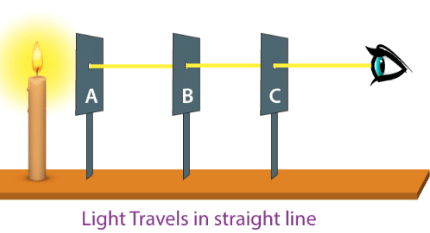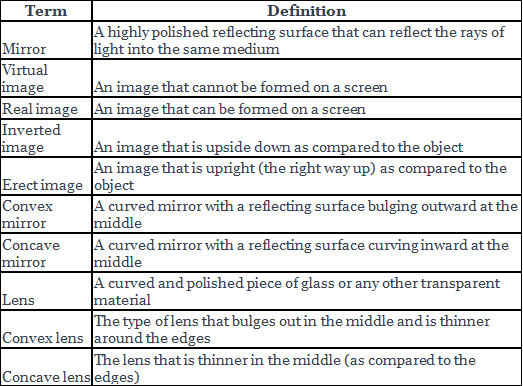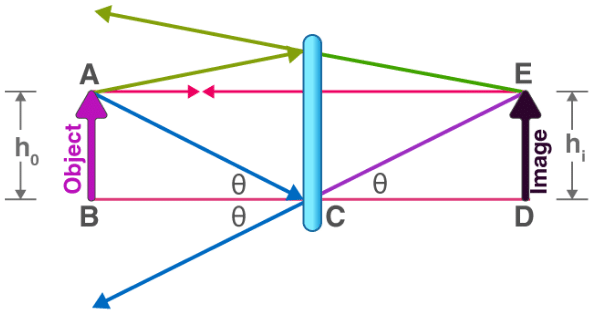Light Class 7 Notes Science Chapter 13
Light is an essential sense that allows us to perceive the world around us. It has been a subject of curiosity for thousands of years, leading to experiments and studies. In this chapter, we will explore the properties and behavior of light, including its propagation, reflection, and interaction with mirrors, lenses, and prisms.
Rectilinear Propagation of Light
Light generally travels in a straight line in a uniform transparent medium or vacuum. This mode of light propagation is known as rectilinear propagation. An activity can help us understand this concept better.

Shadows and Rectilinear Propagation
The formation of shadows is a phenomenon explained by rectilinear propagation of light. When a torch is shone in a dark room, a beam of light is visible. Placing an object, such as a pencil, in front of a lit candle creates a shadow on the wall. The shadow forms because the object blocks the straight-line path of light. Similar situations occur in our daily lives, where objects obstruct light and create shadows. For example, if a friend hides behind a chair, we cannot see them because the chair blocks the straight-line path of light.
Rectilinear Propagation of Light
Light travels in a straight line in a uniform transparent medium or vacuum. This mode of propagation of light is called rectilinear propagation. An activity involving a flexible rubber or plastic tube and a light source can demonstrate rectilinear propagation. Rectilinear propagation is responsible for the formation of shadows.
Reflection of Light
When light falls on an object, it bounces off the surface, resulting in reflection. All types of surfaces reflect light, which is why we can see them. Regular surfaces reflect a parallel beam of light in only one direction, resulting in regular reflection. Irregular surfaces reflect a parallel beam of light in different directions due to bumps and irregularities, resulting in diffused reflection.
Reflecting Surfaces
- The regular surface is a smooth surface, while an irregular surface is rough and wavy.
- The regular surface reflects light in only one direction, while the irregular surface reflects light in all directions.
- Regular reflection is responsible for mirrors, while diffused reflection is responsible for non-mirroring surfaces.
Plane Mirrors
- A mirror is a smooth polished surface that can reflect light rays and form a clear image.
- A plane mirror is a flat reflecting surface, like a mirror on a dressing table.
- When we observe our image in a plane mirror, we can notice certain image characteristics.
- The image is upright, virtual, and of the same size as the object.
- The distance of the image formed behind the mirror is equal to the distance of the object in front of the mirror.
- The image in a plane mirror is laterally inverted.
Activity on Reflection by a Plane Mirror
- The aim of the activity is to study reflection by a plane mirror.
- Materials needed: a plane mirror, a sheet of paper, and a pencil.
- Observation table to be filled up while observing the image in the mirror.
- Observations: the image is upright, virtual, of the same size as the object, and laterally inverted.
- The distance of the image formed behind the mirror is equal to the distance of the object in front of the mirror.
- The size of the image does not change as we move closer or farther away from the mirror.
Spherical Mirrors
A spherical mirror is a part of a sphere and has a curved polished surface that reflects light. They are of two types: concave mirrors and convex mirrors.

- Concave Mirror
A concave mirror is a spherical mirror in which the reflecting surface is the inner surface of the sphere. It is also called a converging mirror because it converges the reflected rays of light to a point. The image formed by a concave mirror can be real or virtual depending upon the position of the object. - Activity
To study the type of image formed by a concave mirror, we can take a concave mirror and an object like a pencil or pen. Place the object in front of the mirror and observe the image formed. Depending on the position of the object, we can observe a real or virtual image. - Convex Mirror:
A convex mirror is a spherical mirror in which the reflecting surface is the outer surface of the sphere. It is also called a diverging mirror because it diverges the reflected rays of light away from each other. The image formed by a convex mirror is always virtual and smaller in size. - Uses of Spherical Mirrors:
Concave mirrors are used in reflecting telescopes and shaving mirrors. Convex mirrors are used in rear-view mirrors of vehicles and in security mirrors in stores.
Image Formation with a Concave Mirror and a Well-Lit Window
Activity
1. Hold the concave surface facing a well-lit window.
2. Adjust the angle of the mirror to form a reflected image on the adjoining wall.
3. Examine the image closely.
4. Go outside on a bright sunny day and hold the concave surface facing the sun.
5. Adjust the angle of the concave surface to form a sharp image of the sun on the screen.
Observations
1. Analyze the images formed on the wall and the screen.
2. Record observations and fill in the provided table based on the observations.
Convex Mirror (or Diverging Mirror)
A convex mirror is a spherical mirror in which the reflecting surface is the outer surface of the sphere. It is also known as a diverging mirror because it diverges or spreads out the light rays. It forms virtual, upright, and diminished images of objects placed in front of it.
Uses of Spherical Mirrors:
- Concave Mirrors: These mirrors are used in dentist's mirrors and shaving mirrors. They are also used in solar power projects.
- Convex Mirrors: These mirrors are used as rear view mirrors and wing mirrors in vehicles. They are also used in supermarkets and parking lots.
Application of Light:
- Optics: The study of light and its properties is known as optics. It is used in cameras, telescopes, and microscopes.
- Communication: Light is used in optical fibers to transmit data over long distances.
- Photosynthesis: Plants use light energy to produce food.
Spherical Lenses
Lenses are curved and polished pieces of glass or transparent material that can change the direction of light. There are two types of lenses- convex and concave lenses.
Convex Lens
A convex lens is a lens that bulges in the middle and is thinner at the edges. It is also known as a converging lens. It is commonly used in magnifying glasses and reading glasses.
Concave Lens
A concave lens is a type of lens that is thinner in the middle and thicker at the edges. It is also known as a diverging lens. Concave lenses are used in spectacles of negative power.
Uses of Lenses
Lenses are curved pieces of glass that can refract (bend) light. Convex lenses are thicker in the middle and are used as reading glasses and cameras. Concave lenses are thinner in the middle and are used to correct short-sightedness and in microscopes and telescopes. Both convex and concave lenses are used in spectacles.
Our Eyes
Our eyes also have lenses that help focus light on the retina. The retina contains cells that send signals to the brain, which then interprets the signals as images.
Colours
White light is composed of many colours. When white light passes through a glass prism, it splits up into its constituent colours. This is called dispersion of light. The band of colours seen on a screen is called the visible spectrum. Objects absorb some colours and reflect others, which is why they appear in different colours
Newton's Disc
- Newton's disc is a coloured disc painted with the constituent colours of white light in equal proportions
- When rotated very fast, the disc appears white due to the persistence of vision
- This means that the images of the different colours overlap in our eyes, and our brain perceives it as white
Know Your Scientist
- Isaac Newton was born in England in 1643
- He was an eminent scientist who made significant contributions to Physics and Mathematics
- His experiments with light led him to propose that white light is a mixture of several colours
Key Words

Activity 1:
Verifying Straight Line Propagation
Aim: To verify that light travels in a straight line.
Materials needed: A flexible rubber or plastic tube/straw (10 inches in length), a light bulb/candle/lamp.
Method:
Hold the tube straight and point one end towards the light source.
Look through the other end of the tube. Observe what you see.
Bend the tube and repeat the observation.
Observation: When the tube is held straight, the light source can be seen. However, when the tube is bent, the light source becomes invisible.
Conclusion: This activity demonstrates that light travels in a straight line.
Activity 2:
Types of Images Formed by a Convex Mirror
Aim: To study the types of images formed by a convex mirror (adult supervision required)
Materials needed: A convex mirror, a candle with a holder, a table top, a thick piece of cardboard covered with white paper (screen), and a plane mirror
Method:
1. Place a lit candle on the table-top between the screen and the convex mirror.
2. Place the convex mirror close to the candle and move the screen back and forth to get an image of the candle flame on the screen.
3. Repeat this for various distances between the candle and the convex mirror.
4. Look into the convex mirror from behind the candle and observe.
Observations:
1. The image formed by a convex mirror is upright.
2. We cannot touch the image formed by a convex mirror.
3. The image formed by a convex mirror is virtual.
4. The size of the image formed by a convex mirror is smaller than the object.
5. There is a connection between the upright nature of the image and the virtual nature of the image.
6. a. When we move the object closer to the mirror, the image becomes smaller and moves farther away from the mirror.
b. When we move the object farther away from the mirror, the image becomes larger and moves closer to the mirror.
c. When the object is very close to the mirror, the image becomes larger and moves farther away from the mirror.
Activity 3:
Images Formed by a Convex Lens:
To study the images formed by a convex lens, we can perform an activity with adult supervision. We need a convex lens, a screen, a candle, table-top, and measuring tape/ruler.
Method:
1. Hold the convex lens facing the sun and keep the screen behind it. Move the lens back and forth until you get a sharp image of the sun on the screen.
2. Place the lens between the screen and candle. Start with the lens very close to the candle and move the screen back and forth until you get a sharp image on the screen.
3. Repeat the activity by slowly increasing the distance between the candle and the lens and move the screen back and forth each time to get a sharp image.
4. Make a note of the image characteristics like real/virtual, upright/inverted, and diminished/enlarged.
Observation and Conclusion:
If the lens is very close to the candle, we cannot get an image on the screen. Such an image is called a virtual image. If the lens is at a distance from the candle, an image is formed on the screen, and it is called a real image. A convex lens forms both real and virtual images. It forms a virtual enlarged image when the object (candle) is very close to the lens.
Activity 4:
Aim: To study the images formed by a concave lens.
Materials needed: Concave lens, screen, and candle.
Method: Place the concave lens between the screen and the lit candle. Move the screen back and forth to get an image of the candle flame. Look at the candle through the lens.
Observation: No matter where you place the screen, lens, or candle, you will not be able to get an image of the candle flame on the screen. However, if you look at the candle from behind the lens, you will see a diminished, upright image of the candle.
Conclusion: With a concave lens, no matter where you place the object, you will always get a virtual diminished, upright image.
|
139 videos|151 docs|18 tests
|

















